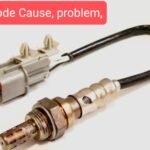Air is the adversary of any coolant system. Air bubbles in a radiator commonly cause engine efficiency loss, overheating, and premature wear. This post from Mrcarinfo explains how to remove air from the coolant system.
Table of Contents
Accumulation of air causes
Air can enter your engine’s coolant system via a breach in any component, including hoses and seals. Please consult a trained mechanic who can accurately identify problems with your radiator cap, thermostat, water pump, or hoses using their knowledge and experience servicing comparable parts on other vehicles. This is especially crucial if you are unsure or suspect an internal leak in one of these components.
Air can also enter the cooling system through faulty components like a faulty thermostat or water pump impeller blades becoming bent due to overheating during operation without sufficient coolant System available at all times while driving around town on hot summer days-this causes increased wear, which eventually leads to failure when either part begins leaking large amounts of hot fluid onto nearby surfaces such as spark plugs/valve covers, which could cause fi.
The Symptoms of Air in Coolant Systems
Several signals indicate an air-filled cooling system. Overheating is one of the most evident indications of a problem.
The engine may overheat due to an internal leak or because the thermostat failed to open, allowing coolant System to flow through the engine when necessary.
Other symptoms include:
- Unusual engine noises (e.g., tapping or knocking).
- Visible leaks near hoses or gaskets.
- When you idle or drive slowly, your tailpipe emits white smoke.
Required Tools and Equipment
This job requires the following tools and equipment:
- Motor oil (about 2 quarts)
- Coolant (1 gallon)
- Coolant recovery bottle
The Step-by-Step Guide to Removing Air from Coolant Systems
Read the stages below to receive a thorough understanding of how this method works:
Phase of preparation
Before you begin, ensure that your automobile is turned off and cool. Then, turn off the engine and remove the radiator cap. Check the coolant level in the reservoir by removing the filler cap (if applicable) or poking a small hole in it with an ice pick or screwdriver. If more coolant is required, add it until it reaches total capacity-but make sure you fill it! Now, put everything back together.
- Install your new hose with washers on both ends.
- Reattach any remaining hoses that were removed during installation.
- Lastly, replace your radiator cap by hand-tightening it until it is snug (do not overtighten).
Coolant Bleeder Valves Location
The coolant bleeder valve is a small screw cap located on the radiator cap. The coolant bleeder valve is typically positioned on top of the radiator. However, it can also be found on either side or at the bottom of some radiators.
To locate your car’s coolant bleeder valves:
- Open your hood and examine for indicators of the engine compartment, such as belts, hoses, and cables.
- Look for any devices with air bubbles coming out of them; this indicates that there are air bubbles in your cooling system, which you should use to drain.
Purge Procedure Initiation
The first step in purging your coolant system is to start it and open the coolant leak valve. This permits air to escape from within the vehicle as you drive, allowing you to release any trapped pockets of air that may cause difficulties later on.
After you’ve done this, let your engine’s coolant run out of this line before closing again to avoid trapping extra air.
Complete air removal
It would help if you did a few quick checks to ensure all air has been evacuated from your cooling system.
- First, use a vacuum pump to remove leftover air from the coolant system. This will assist in preventing future issues with overheating or freezing caused by trapped pockets of air within the system.
- After using your vacuum pump, check the pressure in each cooling system component. Assume there is no pressure anywhere (including the ends). In that instance, trapped air pockets within those locations may still exist. They require additional inspection before they may be deemed safe again.
- It is significant because it can damage and strain parts like seals and gaskets, causing them to break prematurely if not properly maintained.
Air Removal Alternatives
There are alternative methods for removing air from your antifreeze and coolant system if a pressure tester is unavailable or inconvenient.
- Take your car to a repair and have them remove the air from the system. This is the most excellent option if you have minimal familiarity with cars and want someone else to handle the task. The disadvantage is that it can be expensive if they charge by the hour or mile (which many mechanics do).
- Use a vacuum pump instead of manually pumping out the coolant (as indicated above). This method involves attaching a vacuum pump hose to both hoses leading from under the hood, one going into each radiator side tank, and turning on both pumps at the same time until they start sucking the air out through each hose. After turning off one hose so that only one remains connected, pump until there are no more bubbles coming out from either hose/tank connection point. Then reconnect both hoses and turn off both pumps.
Avoid these common mistakes
When working on the cooling system, always wear safety glasses and gloves. Ensure you have an air compressor or pressurized air tank for the work and a pressure gauge to monitor your progress.
System check after purging
After purging the system, check the engine temperature. If it remains too high, it could be because air is trapped in the cooling system.
If your coolant level is low, add until it reaches the recommended level (or higher, if possible).
Extending the life of the coolant system
You can extend the life of your coolant system by monitoring coolant levels regularly and ensuring they are filled to the proper level.
It would be beneficial to replace it every few years or whenever an oil change or other maintenance service is performed on your car.
- Avoid using excessively cold or hot water when filling your radiator, as this could cause air bubbles to form in the system and over-inflate it, potentially resulting in leaks or cracks in hoses, tanks, and radiators.
- Avoid using ethylene glycol-based antifreeze, as it is more harmful than propylene glycol. It may cause harm if consumed by children or pets that consume spilled fluid from car cooling systems (which occurs more frequently than most parents realize).
Conclusion
In conclusion, air in the coolant system is a common yet often overlooked issue that can seriously affect your vehicle’s performance and reliability. By understanding the causes, symptoms, and remedies for air infiltration, you can safeguard your engine against unnecessary damage and ensure smooth sailing on the road ahead.
FAQ’s
How do I get air bubbles out of the cooling system?
Burping the cooling system will fix air bubbles. Give the engine a few minutes to run. Let the engine reach operating temperature. This will open the thermostat and circulate the coolant. Air bubbles trapped in the system will be released during this process.
Where do I find the air in my coolant system?
- Remove the Radiator Cap.
- Insert a Funnel into the Radiator.
- Fill the Radiator with Coolant.
- Start the Vehicle.
- Set the heat to high and the fan to low.
- Top off the radiator’s coolant as the level drops.
- Test the Interior Heat.
- Check the Temperature Gauge.
What is the principle of cooling air?
Air cooler cooling principle ( cooling with compressed air ): A large centrifugal force acts on the vortex generated inside the air cooler, causing a sudden increase in pressure and density, increasing resistance and raising the temperature. At this time, the outer side of the vortex has a higher circumferential speed and a higher temperature, creating a large pressure difference between the center of the vortex.
What is the flow of coolant in the radiator?
Radiator structure
- The cooling water that passes through the tubes in the radiator is cooled by the wind or fan while the vehicle is running.
- Cooled water collects in the lower tank inside the radiator.
- Cooling water flows through the hose to the engine’s water jacket ( cooling water channel), lowering the engine temperature.
- The coolant that absorbs heat from the engine and becomes hot collects in the upper tank of the radiator.
What is the coolant flow in the engine?
Coolant fluid is a liquid used to cool the engine. The coolant fluid that has taken heat from inside the engine is cooled by a radiator installed at the front of the car and then returns to the engine to cool it down. What is required of coolant fluid is that it does not freeze even in winter and that it does not cause rust or corrosion inside the engine even after long periods of use.
What is the flow of cooling water in the thermostat?
How a thermostat works: After the engine starts, when the engine temperature rises and the coolant temperature rises, the valve opens gradually, allowing the coolant to circulate to the radiator. The valve then closes again when the coolant reaches an appropriate temperature to maintain the engine temperature.
How do cooling fins work?
Function and mechanism of heat dissipation fins How heat dissipation using a heat sink works When a heat sink is installed on a heat-generating element, the heat is transferred from the heat sink to the fins, which receive heat from the heat-generating element and is radiated from the fins into the air. Function and structure of heat dissipation fins: Depending on the shape of the fins (surface area and fin spacing), convection occurs in the transferred heat.









